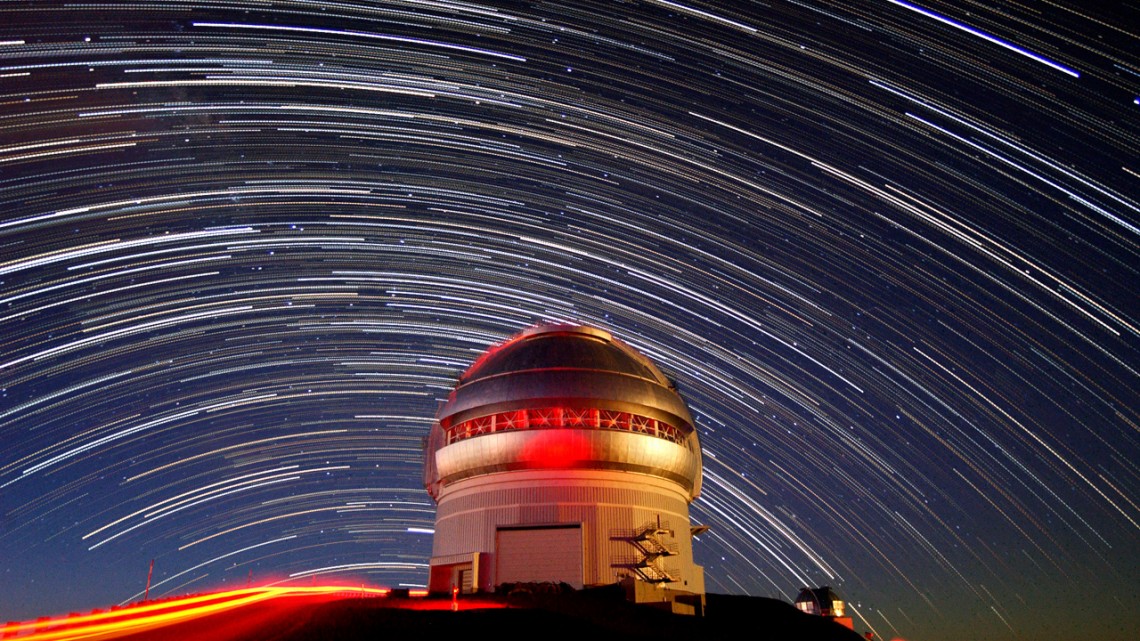
Star trails are pictured over Gemini North, located near Hilo, Hawaii. The observatory will be home to the Gemini Planet Imager, which is being upgraded by a team that includes assistant professor Dmitry Savransky.
Telescope upgrade, move will aid in search for exoplanets
By Eric Laine
Thousands of planets orbiting stars other than our own – known as extrasolar planets, or exoplanets – have been detected and cataloged over the last 30 years. A new effort will set the stage for the discovery of fundamentally different kinds of planets – very young and very large.
Dmitry Savransky, assistant professor of mechanical and aerospace engineering, is a co-investigator on a $2.6 million National Science Foundation grant aiming to improve the search for exoplanets by upgrading the Gemini Planet Imager (GPI), a key instrument of the Gemini Observatory.
“In order to understand how something as old as the solar system developed, we need examples of similar systems at all different ages,” says Savransky. “GPI is capable of detecting very young, very huge planets, giving us a glimpse of what planets like Jupiter may have looked like at the beginning of their lives.”
The Gemini Observatory consists of twin telescopes, on mountains in Hilo, Hawaii, and La Serena, Chile. This summer, the GPI installed at the Chilean telescope will be removed and transported to the U.S., where a multi-institutional team will upgrade it to improve its sensitivity and usability.
Savransky’s work is in collaboration with Stanford University; the University of California, San Diego; and the University of Notre Dame, where the GPI will reside during the 15- to 18-month upgrade. Once complete, “GPI 2.0” will be installed at the Gemini Observatory in Hawaii.
“The Cornell team has two major roles in this project,” Savransky said. “First, we are leading the systems engineering effort. This involves tracking requirements derived from the science goals and ensuring that what we are building is going to achieve those goals.
“Our second role is leading the software upgrade,” he said. “GPI has to align itself between each observation and then maintain that alignment, and we want to improve on how it does this, as well as make updates required by all the new hardware.”
The teams’ ultimate goal is to allow GPI to look at stars and detect planets far more distant and fainter than it can see now. They also hope to improve usability and performance so GPI can be a better resource for all astronomers supporting the Gemini Observatory’s mission of providing access to the entire sky to the international Gemini community.
“We’re specifically trying to detect very bright and very young planets that are very unlike Earth,” Savransky said. “In the process, we also hope to train a new generation of scientists and engineers capable of working on such a cutting-edge system.”
Savransky expects that several of his students will be traveling to Notre Dame during the project; he’ll be traveling to Hawaii for the commissioning, likely in 2022.
“This is a very broad collaboration,” he said, “as was the original GPI instrument team. It draws upon specialized skills and expertise from each institution. Most of the GPI 2.0 team was involved in the original instrument development or science program, and so we are all very excited to have the chance to continue our work with GPI.”
The Gemini Planet Imager is known as the most advanced exoplanet imaging instrument available to astronomers. It uses advanced technologies to correct for atmospheric blurring, to block the light of bright stars and to reveal distant faint planets. The upgrades will enable GPI to operate more efficiently and support studies by the entire astronomical community.
In addition to the National Science Foundation grant, the project received another $1 million from the Heising Simons Foundation, through the University of California, San Diego.
Eric Laine is a communications specialist in the College of Engineering.
Media Contact
Get Cornell news delivered right to your inbox.
Subscribe
